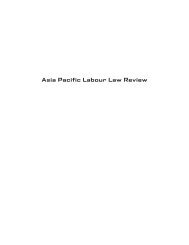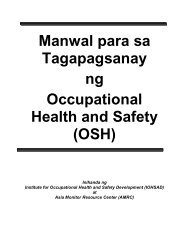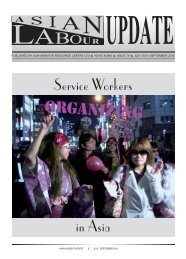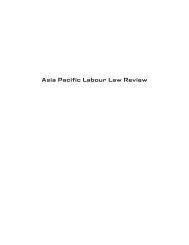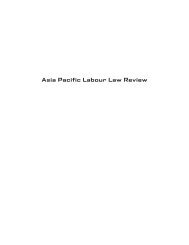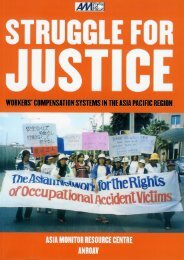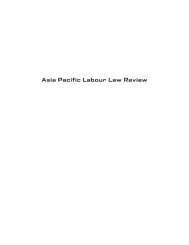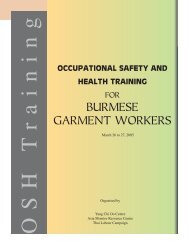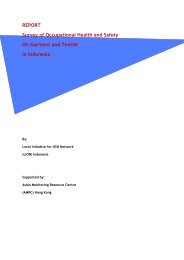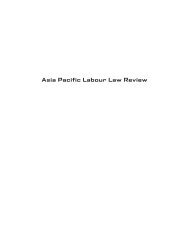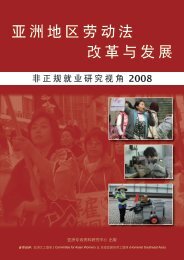OSH Status Report - China - Asia Monitor Resource Center
OSH Status Report - China - Asia Monitor Resource Center
OSH Status Report - China - Asia Monitor Resource Center
- No tags were found...
You also want an ePaper? Increase the reach of your titles
YUMPU automatically turns print PDFs into web optimized ePapers that Google loves.
<strong>OSH</strong> <strong>Status</strong> <strong>Report</strong> - <strong>China</strong> 1Written by: Becky FUNG (LESN) and Francine Chan (WE)1. IntroductionOver the past three decades, while <strong>China</strong> emerged as the “World’s Factory”, a largeproportion of its workers have been increasingly exposed to occupational hazards. By the endof 2001, the International Labour Organization (ILO) estimated that <strong>China</strong>’s workplacefatality rate was 11.1 persons per 100,000 workers, compared with a rate of 4.4 per 100,000 inthe United States. Industrial accidents rose by 27 percent between 2000 and 2001 2 . Accordingto official Chinese government statistics 3 covering the years 2006 to 2009, industrialaccidents increased by more than 15 percent per year. From 1949-2010, <strong>China</strong>’s StateAdministration of Work Safety (SAWS) counted 749,970 cases of occupational disease allover the country. In 2009, 380,000 incidents happened in the workplace that caused death orinjury. Of that total, 83,196 people lost their lives in work-related incidents, meaning that 228workers died every day that year 4 . In <strong>China</strong>, monitoring working conditions remains a greatchallenge, especially in small–scale enterprises, where most of the industrial accidents are notreported at all. In <strong>Asia</strong> in general, we have found that the official statistics and reports ofoccupational accidents and fatalities reflect only the tip of the iceberg, but not the realsituation on the ground. Due to the legitimate reasons, and illegalities, exploitation for theunderreporting of occupational disease and injury in the workplace in <strong>China</strong>, the situation ofoccupational safety and health (<strong>OSH</strong>) in <strong>China</strong> has also been found to be more serious thanthe official presentation.The present report is the result of the discussions and common concerns raised at the2010 <strong>Asia</strong>n Network for Rights of Occupational and Environment Victims (ANROEV). Theseconcerns were mainly the unreliability of the existing data on <strong>OSH</strong> conditions across <strong>Asia</strong>ncountries, which in turn obstruct the understanding of <strong>OSH</strong> conditions in these countries.During 2010 and 2011 <strong>Asia</strong> <strong>Monitor</strong> <strong>Resource</strong> Centre (AMRC), Worker Empowerment (WE),and Labour Education and Service Network (LESN) joined forces to produce this report onthe <strong>OSH</strong> conditions in <strong>China</strong>. We trust it will contribute to the discussion and understandingof <strong>OSH</strong> conditions in <strong>Asia</strong>, and toward building the platform of NGOs striving for the rightsof victims of occupational injury or disease.In this paper, we first outline the current institutional framework concerning <strong>OSH</strong> in<strong>China</strong>, the laws and regulations, their enforcement and their effectiveness. Secondly, weanalyze the available official data on <strong>OSH</strong> conditions in <strong>China</strong> and contrast it with datagathered by community-based organizations. In this way we will be able to obtain a clearerand truer picture of the actual <strong>OSH</strong> situation in <strong>China</strong> and analyze the causes for the gaps inthe two sets of existing data. This study relies on two types of data. On the one hand,1 The report was originally presented at the annual meting of <strong>Asia</strong>n Network for the Rights of Occupational andEnvironmental Victims (ANROEV) in India in November 2011.2 Garrett D. Brown and Dara O’Rourke. “The Race to <strong>China</strong> and Implications for Global Labour Standards”.International Journal o Occupational and Environmental Health, 2003; 9, p.229-300.3 <strong>China</strong> Labor Statistical Yearbook, 2007-2010, and <strong>China</strong> Labor and Social Security Yearbook, 2007-2010.4 <strong>China</strong> Labor Statistical Yearbook, 2010.
<strong>China</strong>quantitative research has been done by reviewing desktop descriptive statistical data gatheredfrom the following sources: <strong>China</strong> Statistical Yearbooks from 2003 through 2010, <strong>China</strong>Labour Statistics Yearbooks, and <strong>China</strong> Labour and Social Security Yearbook, published bythe Ministry of Statistics and the Ministry of Human <strong>Resource</strong>s and Social Security (MHRSS);and data collected by various community-based worker service centres 5 , which include 409cases from Shenzhen collected in 2009, 4,401 cases from Guangzhou collected between 2003and 2006, and 1,560 cases from Dongguan collected between 2006 and 2009. On the otherhand, this statistical data is contrasted with first-hand qualitative records of occupationalaccidents, injuries and fatalities produced by labour community service centres, which pointout the causes of the gaps in official reports. Qualitative data gathered through workers’ groupdiscussions, and individual and collective case studies are used to document the lives of thevictims, and draw a distinct picture from the statistical reports, hence enabling a deeperunderstanding of workers’ situation and their lives on the ground. Despite the limitations ofthe data 6 , which may only project some faint snapshots of current conditions and regulatorypractices in <strong>China</strong>, it does identify key areas where further research and policy analysis isnecessary. Our goal is to bring forward workers’ voices other than discount the officialpresentation. Finally, we outline NGOs’ strategies in relation to <strong>OSH</strong> and sketch ourconclusions.2. <strong>OSH</strong> Institutional Framework in <strong>China</strong>2.1. Legislative and administrative frameworkIn this section we discuss the existing <strong>OSH</strong> laws and their implementation in <strong>China</strong>.Since the 1990s, the Chinese government has explicitly mandated the establishment of asocialist market economy under the rule by law, which is actually a set of rules pursuing theestablishment of a “harmonious society” and increasing productivity, rather than a legalframework defending workers’ legal rights. Since the start of <strong>China</strong>’s economictransformation to a socialist market economy in 1992, labour conflicts have become more andmore serious; hence, the Labour Law of the People’s Republic of <strong>China</strong> was promulgated onJuly 5, 1994, coming into effect on January 1, 1995. The Labour Law is the basic legal codefor the adjudication of labour relations, and has provided a framework for the labour contractand collective contract systems, a tripartite coordination mechanism, labour standards, asystem for handling labour disputes, and a labour supervisory system, basically shaping a newlaw-based approach to labour relations in consonance with the socialist market economy.Since the 1995 Labour Law, several important laws and regulations have come into force.In <strong>China</strong>, <strong>OSH</strong> measures have been developed under a joint effort of the World HealthOrganization (WHO), the International Labour Organization (ILO), and the InternationalCommission on Occupational Health (ICOH) to protect all employees including workers insmall-scale enterprises or in the informal sectors. <strong>China</strong> signed the International Covenant on5 Data was collected by five community-based workers service centres through hospital visit and case studies.The five service centres are grassroots labour NGOs based in the Pearl River Delta, three in Shenzhen and two inDongguan, which conduct regular visits to hospitals and provide free legal consultation and legal aid services toinjured workers. For reasons of confidentiality and security of our sources, the names of the community-basedorganizations will remain anonymous throughout the report.6 The data are mainly from the local reports produced by different workers services centres. Figures come outfrom a limited sample of workers, highly related to the industries present in the areas near the centres’ locations.However, this data can provide the most reliable up-to-date information on the reality of OHS conditions.18
<strong>China</strong>Economic, Social and Cultural Rights (ICESCR) on October 27, 1997, but still has notratified ILO Convention 155, Occupational Safety and Health, 1981, and ILO Convention 161,Occupational Health Service, 1985. These two conventions are the main internationaloccupational safety and health (<strong>OSH</strong>) conventions.The ILO Japan-<strong>Asia</strong> Pacific Regional Seminar on Occupational Safety and HealthManagement Systems was held in Kuala Lumpur in May, 2001, with <strong>China</strong> participating asone of its eleven member countries. Soon after, in July, 2001, <strong>China</strong> held a tripartite seminar 7to review the national laws and implementation practices, in conjunction with the provisionsof the ILO Conventions mentioned above. The Law of the People’s Republic of <strong>China</strong> onsafety production (hereinafter referred to as the Work Safety Law) was promulgated by theNinth National People's Congress on June 29, 2002, and went into effect on November 1,2002; the Law on the Prevention and Cure of Occupational Diseases (hereinafter referred toas Occupational Disease Control Law), was promulgated on October 27, 2001, and put intoeffect on May 1, 2002. Two years later, the Work related Injury Regulation (hereinafterreferred to as work injury regulation) set a legal framework for work injury compensation,which was promulgated by the State Council on April 27, 2003, and put into effect on January1, 2004.The aforementioned OHS-related legal framework stipulates basic principles governingthe prevention and control of occupational diseases, protective measures, hazards monitoringand management in workplaces, diagnosis of occupational disease, health authorityinspections, and the liabilities incurred by those violating the law. Moreover, these nationalregulations define workers’ occupational health rights, the obligations and duties of employersto protect the health of their employees, the responsibilities of the governments at variouslevels, and trade unions’ representation in workers’ health protection.Nevertheless, <strong>OSH</strong>-related laws are only broad guidelines that the State Council decreesand passes downwards through a decentralized administrative structure to the People’sCongresses at the provincial level and local departments which are responsible forimplementing them. However, lower level governmental agents can also issue their own localregulations at the local bureaus of Human <strong>Resource</strong>s and Social Security 8 or at local People’sCourts. Due to the number of different authorities involved in legislating and administrating<strong>OSH</strong> matters, coordination among them becomes highly problematic, and the implementationprocess can be distorted. This situation may be the cause of the gap between the legalmandates and the practices on the ground, where in some occasions, no regulation applies, oreven different and contradictory indications co-exist.7 “The ILO consistently works with its tripartite constituents as represented by the Ministry of Human<strong>Resource</strong>s and Social Security (MOHRSS), the All-<strong>China</strong> Federation of Trade Unions (ACFTU), and <strong>China</strong>Enterprise Confederation (CEC). The aim of such cooperation is to overcome the challenges in Chineseemployment by working together.” The ILO in <strong>China</strong>:http://ilo-mirror.library.cornell.edu/public/english/region/asro/beijing/inchina.htm8 Even the name of regional offices of the government’s Department of Labour and Social Security is not unifiedin province and city level. After 2008, some offices of the Department of Labour and Social Security changedthe name to Department of Human <strong>Resource</strong>s and Social Security.19
<strong>China</strong>Above and beyond this administrative maze, the local regulations at different provinciallevels can be highly influenced by the investors in the area, as local legislators tend to protectemployers’ interests allowing them to save on costs, at the expense of worker’s rights.Workers’ rights are additionally vulnerable as the role of the All-<strong>China</strong> Federation of TradeUnions 9 (ACFTU) is a two-fold role: It acts as both an agent of the government andnominally of the workers, while additionally supporting enterprises. According to Article 7 ofthe Work Safety Law, “trade unions shall, in accordance with law, make arrangement foremployees to participate in the democratic management of and supervision over work safetyin their units and safeguard the legitimate rights and interests of the employees in worksafety.” The ACFTU is supposed to monitor the enforcement of the law, and ensure thatworkers’ rights are not violated. Although in recent years, the number of trade unions underthe ACFTU has increased their functioning is still severely limited by a top-down unionstructure and a weak membership base. In practice, the ACFTU only provides passiveintervention if the worker requests its assistance.Overall, although <strong>OSH</strong>-related laws and regulations are in place, due to a decentralizedadministrative structure and the conflicting interests of the different governmental agenciesand actors involved in the implementation process, the protection afforded under the law isweakened, and workers’ rights are repeatedly violated.2.2. Enforcement in a complicated administrative structureAs mentioned above, one of the fundamental reasons that cause the intricate problems inthe Chinese <strong>OSH</strong> system is that the implementation mandate of <strong>OSH</strong> related laws isdistributed between different government bodies. At the central level, the health and worksafety administration authorities are, namely, the Ministry of Human <strong>Resource</strong>s and SocialSecurity (MHRSS), the Ministry of Health (MH), and the State Administration of WorkSafety (SAWS). These actors and other related departments have overlapping roles andresponsibilities, which cause the problems in the implementation and enforcement of<strong>OSH</strong>-related laws.Firstly, the Ministry of Human <strong>Resource</strong>s and Social Security is charged with enforcementof the law, and will issue mandatory ‘Notes for Compliance’ to factories that violate theregulations. It also investigates serious cases of occupational injury and accident, monitoringthe factories with high occupational risks. It is responsible for handling the issue of workinjury certifications, to arrange identification of disabilities, and to provide work injuryinsurance to the injured workers. The ministry relies on the Department of Human <strong>Resource</strong>sand Social Security at the provincial level, which supervises the municipal bureaus of Human<strong>Resource</strong>s and Social Security at the municipal levels.9 The All-<strong>China</strong> Federation of Trade Unions is the sole national trade union federation of the People's Republicof <strong>China</strong>. It is the largest trade union in the world with 134 million members in 1,713,000 primary trade unionorganizations. The ACFTU is divided into 31 regional federations and 10 national industrial unions. ACFTU hasa monopoly on trade unionizing in <strong>China</strong> and the creation of competing unions is illegal. As a tool of thegovernment, ACFTU has been seen as not acting in the best interest of its members (workers), bowing to thegovernment pressure on industry growth and not defending workers' rights. The ICFTU, noting that the ACFTUis not an independent trade union organization, concludes that it cannot be regarded as an authentic voice ofChinese workers.20
<strong>China</strong>The Ministry of Health relies on the Centre for Disease Control and Prevention (CDC)and the local Prevention and Treatment Centre for Occupational Diseases at variousadministrative levels as its key agents carrying out health inspections. The Prevention andTreatment Centre for Occupational Diseases also investigates the identification and therapy ofoccupation diseases.The State Administration of Work Safety (SAWS) regulates and monitors the safety andhealth working environment, to prevent the workplace from developing sources of hazards orinjuries, such as fire, dust, poisoning, harmful noise, radiation, etc. One of its duties is to visitfactories and mines regularly and set up health and safety files on the workers. When the localPrevention and Treatment Centre for Occupational Diseases receives a case of occupationaldisease or complaint from a worker, the State Administration of Work Safety carries out aninspection of the factory and reports back to the local Prevention and Treatment Centre forOccupational Diseases to issue the occupational disease certificate.The lack of co-ordination between the ministries and bureaux leads to very low efficiencyin terms of implementation and monitoring, therefore prevention of accidents and injuriesalways seems to fail. Corruption and abuse of power by the authorities are the most commonreasons for this. Although the local labour department or the local trade union under theACFTU may try to carry out inspections, the labour department alone is not powerful enoughto stop factories from violating safety standards and refusing to pay compensation to workers.Moreover, migrant workers are usually pushed back and forth between various departmentswhen they seek the intervention from the authorities to resolve their occupational injury case,as this report from a benzene-poisoned worker highlights:“I’m seeking compensation to pay for the treatment. The boss in thefactory totally refused to discuss the issue with me. I went to the Bureau ofHuman <strong>Resource</strong>s and Social Security to complain and ask for help. All thismoney should be paid by the boss first, and after he can claim the moneyback from the Ministry of Human <strong>Resource</strong>s and Social Security. The officersin the Bureau of Human <strong>Resource</strong>s and Social Security said they had calledthe factory already. They did their job. Since I am desperate for a result onthe payment of the treatment fee, I just stayed in their office and refused toleave. They then suggested that I go to the trade union to ask for help. WhenI arrived at the trade union office, luckily I chatted with the newly-arrivedtrade union chairperson, who was a woman of about 30 years old. Maybebecause she’s new and young, she didn’t know too much about the powerstruggle in the area, she agreed to fix the compensation fee within one week.The officer behind warned her: “Hey, that Taiwan investor is a big one, noteasy to fight with, are you really sure you want to help this worker? It’s hardto fix it!” (Wu Zhigang, an occupational disease victim)As Wu’s experience shows, trade unions, and the local government, tend to protect andcoordinate with the enterprises to ensure good relations and that nothing will disrupt therevenues that come from the tax and rent income of the investors. This kind of local21
<strong>China</strong>protectionism and conflicts of interests proliferate through inefficient monitoring andenforcement of the law. Hence, violations and non-compliance with the laws are a frequentoccurrence2.3. Complicated procedures to seek compensationThe formal procedures necessary to seek compensation for occupational injuries ordiseases, as they governed by the aforementioned legal and administrative structure, arecumbersome and complicated. Hence, this section also highlights the difficulties encounteredby workers that seek compensation and the reasons why so many of them give up in themiddle of the process.The procedure to seek compensation is regulated by the Work Injury Insurance Law, theLaw on Prevention and Control of Occupational Diseases, and the Production Safety Law. Inorder to seek compensation, the Work Injury Certification is used to identify and confirm thatthe injury was caused by a job-related issue or accident; the Identification on Work Ability isused to identify the level of disability caused by the injury. There are four major steps in theprocess to seek compensation. First, workers must have their injury identified as anoccupational injury, for which they need to apply for the Work Injury Certification within oneyear after the accident happened in the workplace. Second, workers must apply for theIdentification on Work Ability and wait for the results of this evaluation.To add to this painstaking and time-consuming legal procedure, there are a number ofadditional barriers, which include the labour contract, or the occupational disease diagnosis.Yet even before the compensation can be sought, the injured workers have to submit his or herlabour contract to the authorities to prove the existence of a ‘labour relationship’ with theemployer. Ironically, this is one of the greatest difficulties faced by the injured worker. Thiswas vividly shown in the “Executive Summary of the <strong>China</strong> Labour Contract LawImplementation Survey, 2009”, a report on the Pearl River Delta region (PRD) conducted by aworkers’ centre based in Shenzhen:“The percentage of respondents having signed a written labour contract in thePearl River Delta is 67.30 percent and in the Yangtze River Delta (YRD) it is 83percent. The common contract period is one to three years, and only 8 percentof respondents have permanent contracts. Overall, about 75 percent ofrespondents report having signed labour contracts with their employer in theYRD and PRD. Enterprises with 100 employees or less were found less likely tohave signed labour contracts at all (“Executive Summary of the <strong>China</strong> LabourContract Law Implementation Survey, 2009”, Dagongzhe Centre).In fact, there is a relationship between the size of the enterprise and the rate ofoccupational accidents. The findings of one workers centre show more than 50 percent of allaccidents happen in factories with fewer than 250 workers.22
<strong>China</strong>Table 1. Relationship between factory size and occurrence of occupationalaccidents.Factory size(# of employees)Occurrence of accidents(%)Less than 50 17.750-249 40.4250-499 12.8500-999 9.2More than 1,000 12.1Source: Data from workers’ services centre in Guangzhou. This workers’ centrereaches 20 hospitals and collected data on 4,401 cases of occupational injuriesbetween 2003 and 2006.In the case of workers with occupational diseases, it is more difficult to seekcompensation, since in addition to submitting the employment contract to prove anestablished labour relationship with the employer, occupation disease victims also need toobtain an occupational disease diagnosis before they can obtain a work injury certification.The diagnosis process may take at least nine months, and it can be prolonged to several years.Many occupational disease victims have been trapped for years just in the process ofobtaining the certification, before entering into the legal proceedings to seek compensation.Due to this lengthy process, some workers even die before they can obtain the work injurycertification.After obtaining the certificate, the injured worker will receive a notice from the Ministryof Human <strong>Resource</strong>s and Social Security which will enable them to receive part of theircompensation. The level of disability is divided into ten levels and compensation will dependon the level of the disability. The payment of compensation is divided into three major parts.The Ministry of Human <strong>Resource</strong>s and Social Security provides one third of thecompensation to the worker immediately after the certification is achieved. However, for theworker to achieve the other two thirds of the compensation, which is provided equally by boththe MHRSS and the employers, he or she has to be dismissed or resign. It is not until thismoment that workers are able to obtain the entire compensation payment.Moreover, the calculation of the compensation is done using the average wage of the lasttwelve months before the accident happened. Thereafter, depending on the disability level, theaverage wage will be provided for a fixed period (calculated in months). Hence, workers haveto provide evidence or proof of the average wage of his previous position in the twelvemonths before the work injury occurred. The worker’s difficulties do not end there. If theworker has not kept the pay sheets (pay slips) for the past 12 months – and many have not –he or she must get copies from the MHRSS or employer who may have understated paymentin order to lessen the company’s social insurance payments. The Social Insurance Lawrequires that the employer and the worker share the payment of the social insurance, with23
<strong>China</strong>specific proportions of the actual wages 10 paid by each to the Social Insurance Fund on amonthly basis. In practice, most of the employers use the minimum wage to pay theirproportion to the Social Insurance Fund, which will affect the calculation of the compensationbecause when the worker has no proof of the real wages he/she has been receiving, thecompensation is calculated with the average wages records of the MHRSS (records comingfrom the Social Insurance Fund) and that reflect a much lower average wage than the workers’real wage. This makes the compensation lower than the actual amount workers should receive.To demand for a fair compensation workers have to enter into litigation following the legalprocedures.Nevertheless, the data show that seven out of ten workers are not willing to seekcompensation through the legal procedure. A lack of legal knowledge, and the costly,time--consuming process are the major reasons that deter workers from seeking compensation.Usually, workers use informal methods to bargain with their employers, which lead to a muchlower settlement, often 40 percent lower than the legally required compensation. Moreover, inmost cases, workers that do informally bargain with the employer are immediately asked toresign or are dismissed:“As you can imagine, most of our income depends on the overtime pay. Onceyou get hurt, the factory only pays us a basic salary of Rmb1,200 a month asstipulated in the regulations, but it is not enough to support oneself in the urbanarea. What’s more, the legal procedures usually take more than half a year, andit is too difficult for me to understand those procedures, even appeal at thecourts. I really can’t wait to get the compensation through the proper legalprocedures. I am better off going back to my home village. Living in the city istoo expensive for me.” (Li Changfu, a worker injured on the job)3. Causes of the gap between official statistics and community reportsBelow we analyse the existing <strong>OSH</strong> official statistics and contrast them with reportsproduced by community-based organizations, with the intention of highlighting the causes ofthe gaps between the two sets of data. .Firstly, it should be emphasized that the statistics of occupational diseases and workinjuries are largely under-reported by the mass number of undiagnosed cases among migrantworkers. Particularly, official statistics are missing the figures on those migrant workers whoreturn to their home village after they are dismissed by their employers due to their illness,and also those who give up in the tedious process of seeking compensation. In fact, the Centrefor Disease Control and Prevention (CDC), the Ministry of Health, and the Ministry ofHuman <strong>Resource</strong>s and Social Security admitted that these figures are only based on thenumber of diagnosed cases and those with work injury certifications. Moreover, the dataavailable in the <strong>China</strong> Labour Statistics yearbooks only presents the number of workers thatwere beneficiaries of the social insurance scheme, hence, those that applied to the Social10 Commonly, the actual wages paid to a worker comprise three parts: around 40 percent is the basic salary (paidat the minimum wage), around 55 percent is overtime pay and less than 5 percent is subsidies.24
<strong>China</strong>Insurance Law, and that were able to officially seek compensation and succeeded in getting itfrom the Ministry of Human <strong>Resource</strong>s and Social Security (See Table 2 below).Table 2. Compensation insurance and industrial injury insurance cases,2005-2009Year Work injuryinsuranceContributorsat end of yearChangeoverpreviousyearPeopleBeneficiariesof workinsuranceChangeoverpreviousyearPeopleIdentifiedasdisabledChange overprevious year2005 84,777,999 -- 650,536 -- 511418 --2006 102,684,600 17.40% 778,201 16.40% 605,636 15.60%2007 121,733,619 15.60% 959,996 18.90% 756,623 20.00%2008 137,872,324 11.70% 1,180,000 18.60% 1,011,440 25.20%Sources: <strong>China</strong> Labour Statistical Yearbook, 2007-2009, and <strong>China</strong> Labour and SocialSecurity Yearbook, 2007-2009.In contrast, reports by community-based organizations depict a different panorama.During 2009, one of our <strong>China</strong>-based partners, a migrant workers centre in Shenzhen, visitedand monitored the victims of 409 cases of work-related injuries. Even with the support andlegal consultation services provided by the centre, only half of the workers (232 workers)were willing to apply for the Work Injury Certification. From 2007 to 2009, another migrantworkers centre in Shenzhen handled 2,131 injury-related cases, of which more than half hadno injury insurance provided by the employer. In relation to the distribution of injuries perindustry, data from the 409 work-injured cases show that 21 percent of cases were in thehardware industry, 14 percent occurred in the furniture manufacturing industry, 10 percent inthe construction industry, 6 percent in the plastics products industry, 5 percent in servicesindustry, 3 percent in the printing industry, and 33 percent in other industries 11 . A third reportbased on 1,560 cases from Dongguan indicates that 89 percent of those with occupationalinjuries were male and 11 percent female 12 .Analyzed in terms of the causes of occupational disease, it has been found that since2001, the year when official statistics began listing the item of occupational disease, the maincause of occupational disease has been silicosis. In 2009, more than 91.89 percent of newcases were of silicosis: 14,495 people were said to be suffering from this occupational disease,and 748 died of it. Following pneumoconiosis, occupational poisoning is the second majorcause of occupational disease and death: There were 2,184 affected victims and 21 deaths.Occupational poisoning occurs mainly due to three substances: lead (56.59 percent), benzene(10.88 percent), and arsenic (8.63 percent). Benzene poisoning has caused 22 cases ofleukaemia that same year 13 . However, in 2009, an NGO in Dongguan followed up more than50 workers suffering from leukaemia due to benzene poisoning:11 These figures are based on 409 cases collected in the hospital visiting program in Shenzhen during the year2009.12 These figures are based on 1,560 cases collected by two workers service centers in 2006-2009.13 2009 <strong>Report</strong> on Occupational Disease Prevention and Control, Ministry of Health, PRC25
<strong>China</strong>“In 2010, there were more than 20,000 industrial and mining enterpriseswith occupational hazards problems in Dongguan (a city in GuangdongProvince). They employed more than 5.5 million workers, but only 6,000enterprises reported occupational hazards to the related government offices.The State Administration of Work Safety only monitored 280 enterprises out ofthese 6,000.. Moreover, only 58,000 workers out of 5.5 million workers haveregular occupational health checks, less than 2 percent of the total number ofworkers who are required to have these checks” (Dongguan Daily, 2 Aug,2011).“Until this year (2010), there were only two hospitals in Dongguan withthe qualifications to carry out occupational health examinations. Recently, theHealth Department of Guangdong Province has issued the good news that fivemore hospitals were given occupational health examination qualifications tostart conducting occupational health examinations in the coming year (2011).In total, there are seven hospitals with occupational health examinationqualifications, which can provide services to 5.5 million workers in the area.”(Dongguan Daily, 2 Aug, 2011)Due to the ineffective and inconsistent monitoring of the health and safety regulationsand conditions, many enterprises simply ignore these regulations. Moreover, access to reliableinformation, as has been seen, is scarce. Local media coverage of occupational accidents ispatchy. Although the media often reports the occurrence of serious accidents, informationregarding more sensitive and serious accidents is blocked by the government, whether in themedia or on the Internet. This results from the political pressure of creating a “harmonioussociety” and the government’s censorship of all the “inharmonious” reality and discussion.Therefore, we can only have snapshots of this reality taken from local community cases. Inturn, this report can only estimate the existing gap in the information on <strong>OSH</strong> in <strong>China</strong>. Byusing the existing data, we try to map out the actual <strong>OSH</strong> situation, and call for furtherimprovement in the future.4. Looking into cases of occupational diseases and work injuries4.1. An individual case of a benzene poisoned workerWorker Ng, who worked in a leather factory in Dongguang, suffers from leukaemia dueto benzene poisoning in 2010. After he was diagnosed with acute leukaemia in the hospitaland was identified as a potential case of occupational disease, he approached his employer todemand that he take care of the medical expenses. But the employer refused. Like many otherpatients with occupational diseases, Ng had to overcome many difficulties in the long andtedious process to claim his rights.Generally, the first problem is that the employer always refuses to pay for medical andliving expenses during the application period of occupational disease diagnosis. Even if theemployee is identified as a victim of an occupational disease, it is very difficult for him or herto claim back the medical and living expenses from the company. During the applicationperiod of occupational disease diagnosis, Ng’s employer did not provide necessary evidence26
<strong>China</strong>of the use of toxic chemicals in the factory, which slowed down the entire process. After theWorkplace Injury Identification was finally approved, the employer did not comply with thelaw and did not pay for Ng’s salary and other expenses during the treatment period. Ng waseven forced to sign an agreement with the employer to reduce the cost of living payments thatthe company should pay.Ng and his family made an attempt to file a complaint concerning these problems withthe factory in different government departments such as the Health Inspection Bureau, theLabour Bureau, and the Petition Bureau, but none of the bureaux offered practical assistanceto them and even discouraged their actions, which is a common response many workersreceive when fighting for their rights. It is apparent that there exist great problems in theenforcement of the Work Injury Insurance Law at many levels of government, and patientswith occupational diseases are not only unfairly treated under the existing system, but are alsotrapped in its tedious procedures.4.2. A collective case of GP cadmium-poisoned workersIn 2004, an outbreak of cadmium poisoning cases occurred in four subsidiary factories ofGold Peak (GP) Batteries in mainland <strong>China</strong> as well as in Hong Kong. From that year until2010, a total of 500 workers were diagnosed with excessive cadmium levels in the blood, and22 workers were identified to have been cadmium poisoned. Gold Peak Industrial Ltd. is an<strong>Asia</strong>n transnational corporation (TNC) based in Hong Kong and Singapore. GP’s customersinclude EverReady, Siemens, Panasonic, Nikon, Canon, Rayovac and Toshiba.Cadmium is a chemical used to produce batteries. Workers affected with cadmium willface health problems for years even if they do not show symptoms of illness at the time ofcoming into contact with this chemical. Gold Peak (GP) which had been producing batteriessince the mid-1980s, provided totally ineffective masks to their staff, which resulted inworkers inhaling the fine cadmium powder. The company even ordered pregnant women toprocess cadmium alongside non-pregnant women. As a result, the children of these womenwere also found to have high-levels of cadmium in their bodies due to their mothers dailycontact with the substance. In 2004, greatly suspicion of the official medical tests arranged bythe management of the factory, some of these Gold Peak (GP) workers went to theGuangdong Provincial Hospital for the Prevention and Treatment of Occupational Diseases tohave new medical tests done. The results of these tests were alarming and showed that thelevels of cadmium in their body were much higher than the tests they had been done at therequest of the factory management. The 500 workers were outraged and staged a three-daystrike in June, 2004, demanding the Gold Peak (GP) management recognize the accuracy ofthe second set of test results performed by the provincial hospital and asked for financialcoverage for proper medical treatment.According to an interview with five Gold Peak (GP) employees who had been shown tohave cadmium poisoning, they had been going through a long battle with the company to fightfor their rights and compensation. Gold Peak (GP) at one point forced them to resign and signunfair compensation agreements. The affected workers were under great pressure from thecompany and the local authorities, which included close surveillance of their actions and evenviolent assaults. In response, workers at the factories went on strikes, staged protests, met27
<strong>China</strong>with government officials, and filed a lawsuit to exert pressure on the company. With thesupport from labour groups in Hong Kong, a number of demonstrations were held at theoffices of Gold Peak (GP) in Hong Kong Worker representatives also visited trade unions inEurope seeking assistance. After six years of struggle, in September 2010, 152 formerworkers from the Huizhou factory of Gold Peak (GP), all with excessive cadmium levels intheir systems, won their lawsuit against Gold Peak (GP). The court found in favour of theworkers’ claim for RMB 6.03 million cash compensation. Workers were also grantednutrition fees and wages based on average monthly salary of the urban residents.The success of the collective action of the Gold Peak (GP) workers proved that solidarityamong workers and support groups is essential. In the case of Gold Peak (GP), the activeinvolvement of NGOs in the process, lobbying work, media strategies, and pressure fromforeign organizations all were positive factors that facilitated the success of the workers’movement.4.3. An individual case of an injured workerChen, a 45 year old male worker in the furniture manufacturing industry, suffered hisinjury on March, 2011. In the previous ten years, Chen had worked in eight different factories,seven of which producing furniture. In January 2011, Chen resigned from his position. Afterthe Chinese New Year, Kanan, a furniture making factory recruited workers for their craftproduction line. This specific production process required very experienced and skilfulworkers as some tools with sharp edges are used to make the carved patterns on the woodfurniture. Chen started working at Kanan factory on February 24, 2011, and signed a labourcontract with Kanan which gave him a monthly salary of Rmb2,200-2,300 a month, twoholidays per month, and a work schedule from 8am to 9pm. The manager made an oralagreement with Chen that work injury insurance would be provided at a later date.Chen was sent to the production line with no training whatsoever, and the divisionmanager just asked him to observe and learn how the other workers used the machines and thetools. As Chen had not worked in such a skilled carvers division before, the productionprocess was new for him. Six days after entering the factory, on March 3, 2011, when Chenwas carving the patterns on a wardrobe, he severely injured the palm of his left hand. Theother workers at the workplace tried to stop the bleeding and immediately sent Chen to thehospital. At the time, Kanan paid a deposit (part of the treatment fees) to the hospital andagreed to pay an injury compensation without mentioning any specific amount.As Kanan had not yet provided Chen with work injury insurance, it was actually obligedto pay the treatment fees and other compensation payments in full. For this reason, Kanan’smanagement was not willing to report the injury to the Bureau of Labour and Social Security.However, when Chen’s condition stabilized, he applied for the Work Injury Certification andfor the identification of the level of disability, which was set at level 10. However, throughoutthis process, Kanan was not cooperative.In July 2011, Kanan started to put pressure on Chen to resign, but he refused andreported Kanan’s behaviour to the Bureau of Labour and Social Security. The bureau initiatedconsultations and discussion with both Kanan and Chen individually, but failed to resolve the28
<strong>China</strong>issue. Thereafter, Chen prepared the necessary material and applied for the Bureau of Labourand Social Security’s arbitration committee. At the end of July, the same day that Chenhanded in the arbitration request to the bureau, Kanan informed the bureau of its willingnessto discuss the issue again. Hence, Kanan’s management and Chen met up and Kanan offeredRmb15,000 in compensation to Chen. Chen initially refused. However, due to the anxietiesover the length of the process and his housing and living expenses, Chen finally settled forRmb20,000 in compensation. This, however, was only 59 percent of what he was legallyentitled to as compensation. Had he decided to refuse this offer, he would have had to waitmore than two months for the results of further arbitration to be concluded, in addition tohaving to deal with uncertainty of the outcome of this process.Chen reached the Rmb20,000 compensation settlement after having bargained withKanan management. The words from Kanan’s division manger during the bargaining processare still fresh in Chen's memory: “You want to employ a lawyer? Haha… They (Kanan) alsohave a legal consultant. How long do you think you can play with them? Considering the time,the amount (Rmb 20,000) for us (workers) is almost decent!”5. NGOs’ strategyOur aim is to stimulate workers to defend their right to a healthy and safe workingcondition by themselves. To pursue this aim, NGOs employ the following strategies:1) Provide hospital visits, legal consultation services, legal and paralegal assistance, andorganization of workers’ support groups in the community;2) Assist workers in organizing solidarity actions, such as media appeals and petitions to theauthorities, and support during the litigation procedure;3) Organize public events and action and alliance building with civil society organizations, tocreate a pro-labour support network;4) Advocate for legislative changes in the <strong>OSH</strong> system in <strong>China</strong>, by collecting and analyzing alarge number of cases and by building an advocacy platform that represents workers,mainland <strong>China</strong> and Hong Kong labour NGOs, Chinese academics and legal experts.NGOs’ strategies have the common goal of empowering workers to self-organize andpursue their rights autonomously. However, some basic challenges remain for NGOs,including improving their access to workers and empowering them, especially migrantworkers. For workers who usually have long shifts of nearly 10 to 12 hours a day), it isdifficult for them to access <strong>OSH</strong> information, get legal training or set up contacts with thesupport network to start the empowerment process, let alone engage in self-organization.6. ConclusionThe real statistics on occupational hazards and accidents in <strong>China</strong> remains unknown,which is believed to be highly underestimated and underreported due to poor enforcement andmonitoring of <strong>OSH</strong>-related laws, cumbersome, lengthy process of verification of injury anddegree of disability and a lack of an accountable and transparent mechanism to compilestatistics. Worse still, the hidden problems are diffusing into other <strong>Asia</strong>n countries.In the process of global industrial relocation, enterprises seek locations with the lowestcosts, and with lax and imperfect laws and regulations to reduce productivity risks (as29
<strong>China</strong>avoiding raising production costs). In 2011, the relocation of enterprises settled in <strong>China</strong> hasfollowed two paths: towards <strong>China</strong>’s hinterland or towards Southeast <strong>Asia</strong>n countries. Withthe new industrial set-ups following the old models, these have incited the emergence oflabour and <strong>OSH</strong> problems in other countries. In fact, the <strong>OSH</strong> problems in these newlocations appear as serious as in previous location in <strong>China</strong>, and workers also face low wagesand casualization of labour. The need for a hike in the minimum wage rate and thecasualization of labour are common issues that workers across countries are protestingagainst.We can assume workers in other countries in <strong>Asia</strong> are facing similar situations andproblems as in <strong>China</strong>. Hence, we emphasize the importance of further investigating <strong>OSH</strong>conditions in <strong>China</strong> and elsewhere, not only because the data itself is unreliable, but alsobecause it will provide the basis to further advocate for improvements of <strong>OSH</strong> conditionsacross the region. To better understand the situations on the ground, and to allow workers tobetter make claims and demand their rights and improvement of the labour conditions, furtherresearch is necessary.The most critical challenge for most workers and labour NGOs in <strong>Asia</strong>n countries is tofind ways to contribute to the improvement of <strong>OSH</strong> conditions in a more open and sustainableway under authoritarian regimes. Indeed, if we have the strong conviction that <strong>OSH</strong> is a basichuman right, NGOs should mobilise resources to demand these rights and seek spaces forworkers to enjoy their rights in an autonomous and collective way. Of course, the sustainablestrategy is to empower workers to demand their rights themselves. Workers must realise thatthey are the key actors, they must make themselves visible, and they should speak out, learn,and be actively involved in monitoring their working conditions with their employers.30




